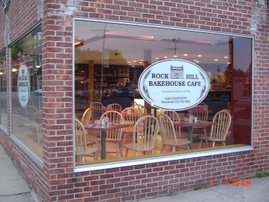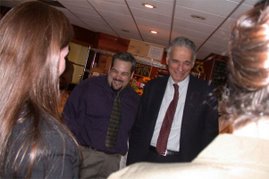Here's an article from the NY Times about Judith Enck. She is Governor Spitzer's Deputy Secretary for the Environment and is also the wife of a friend of mine, former NYS Green Party
Chair, Mark Dunlea.
I have been pretty critical about the "greening" of the Executive mansion. The issue is discussed in the NY Times article below and was apparently one of Judith's initiatives. My cynicism about this example of "ecological leadership" stems from my belief that the government needs to lead by establishing programs and policies that make "greening" possible for the majority of us who can't afford it, not by making token gestures with our tax money. I feel that if they
really wanted to "green" the Executive mansion, they would fist need to "unmansion" it, first. One of the biggest wastes of energy resource in this country is our insanely excessive use per capita, of living space.
What is a REASONABLE amount of living space for an individual to use? While thats a difficult benchmark to establish with any certainty, it is fairly interesting to know that the average in many poorer countries is less than 30 square feet per person. How do we, as Americans, measure up to that?
It will surprise no one when I say ... not very well. We use 20 - 30 times more living space than the average global citizen. We also live in about 4.5 times more space than we would if we were to live in a reasonably ecological manner. The average house in the United States is about 2250 square feet. According to the last census, we each use about 872 square feet of that! Oasis Design, a "green" home design group, states in its guidelines on ecologically-sound homes, "120 square feet for two people is possible. 200 square feet per person is generous. At 500+ square feet per person, ecology is out the window."
Following this logic, it is my view that the AMOUNT of living space at the Executive mansion is its biggest environmental foible and not its perceived lack of color. Likely, Judith and Mark would agree. They have always "walked the walk". They have lived in an extremely modest and energy efficient home in Poestenkill for several decades. Unlike their house, the governor's mansion can't be "greened". It is about 20,000 square feet and according to an article I read about it, he and his wife only spend about two nights a week there (apparently, their kids hardly ever stay at all). So ... two people times 104 nights per year times twenty thousand square feet equals .... 70,000 square feet of living space EACH! How wasteful is that, Mister Governor? How much solar energy would one need to capture to make up for that kind of Herculeaen waste of resource? How many flushes from the European low flow toilet would it take to negate that kind of unconscionable overuse?
I am really disappointed that the best example the Spitzers can set is to spend $650,000 taxpayer dollars to change some light bulbs and put up some solar panels. Why not do something truly meaningful and completely alter the mass perception of how a Governor is supposed to live in this "new American century"? How about moving the whole operation to a GREEN Executive HOUSE and abandoning the whole mansion concept entirely? Why not turn the mansion into a museum and charge admission to cover the (now reduced) heating bills? Why not rent it out to rich voyeurs who want to spend the night or have their wedding receptions there? Show us that you REALLY are a different kind of politician. MAYBE, over thirty years ago, when Jimmy Carter solar-paneled the White House it was okay to think of it as a symbolic gesture and a nod towards clean, renewable energy. Today, this type of "greening" transcends the symbolic and enters the realm of pandering. This was an extremely patronizing maneuver and a hypocritical one, as well. If the Spitzer government wants to set the ecological bar higher they need to create and fund government grants and incentives for all of us New Yorkers who simply cannot afford to effect meaningful "greening" without meaningful "greenbacks". ;-)
May 4, 2007
Public Lives
From Voice of the Bottle Bill to Keeper of the Green
By ROBIN FINN
ALBANY
ODD, but the color green is nowhere present in the Capitol office occupied by a mountain range of paperwork and the tart-tongued Judith Enck, Gov. Eliot Spitzer’s deputy secretary for the environment, who began her career as a bottle-bill lobbyist and Naderesque nag about government eco-insensitivity. Reprising the role she played during Mr. Spitzer’s eight years as attorney general (it was her idea for him to hire her away from the New York Public Interest Research Group and bring his nascent environmental agenda up to snuff), Ms Enck is his adviser on all things green.
Or all things potentially green, which is why she was gratified last month when New York State’s first lady, Silda Wall Spitzer, embraced her whimsical but doable suggestion for a greening of the energy-guzzling governor’s mansion.
Or all things that should stay green, which is why she advised Mr. Spitzer to dig in and fight a 190-mile high-voltage transmission line through central New York that, as originally planned, would snake across seven counties, 154 streams or rivers and 155 mapped wetlands.
“It would have an enormous aesthetic impact, while the economic benefits are not that clear,” Ms. Enck says. Relocating the line alongside the New York State Thruway might be a viable compromise. As for her own personal environmental footprint, she shrugs: “I’m sure it’s huge. I’m a typical American.”
Not exactly. Her transportation of choice is a Toyota Prius. Her small house is heated by two cords of wood and sunshine. She recycles and composts like a fiend. “But I feel really guilty because I live a half-hour from where I work and I don’t carpool,” she says. (Maybe that’s because she has only five neighbors at Common Farms, a 185-acre collectively owned preserve in the town of Poestenkill, where she built her house.) “And I occasionally vote Republican,” she stage whispers, “but only for local candidates.” Her nonpartisan weakness — she is a nominal Democrat — is female candidates with a sympathetic environmental stance and smart fiscal policies.
The opportunity to make rather than simply influence environmental policy is why Ms. Enck left the advocacy side of the aisle to work for Mr. Spitzer: “Rather than knocking on the door from the outside, I wanted to shape policy from the inside.” The Pataki administration was aghast when she joined the attorney general’s senior staff, and referred to her as “a bomb thrower.” It still annoys her. “Since when is being an advocate for recycling equivalent to throwing bombs?”
Ms. Enck wryly refers to her wing of the building as “the unarmed side of the Capitol” — less security, but more recycling bins. There was just one on her floor in January. Now there are 25.
THE highlight of her office ephemera, aside from plaques and bumper stickers with the slogan “Well Behaved Women Rarely Make History,” is an autographed black-and-white photograph of Jon Stewart, the irreverent talk show host. Two tickets, souvenirs of her visits as a member of the studio audience, are tucked into the frame.
Ms. Enck, 47, makeup-free and unfussily attired in a black pantsuit, confesses to being a serious Stewart groupie. It is an addiction tolerated, if not shared, by her husband, Mark Dunlea, a lawyer and former state chairman of the Green Party who is now with the Hunger Action Network.
Mr. Stewart’s photograph arrived after a friend surreptitiously wrote to him describing Ms. Enck’s decision to donate a kidney to her brother-in-law; the friend was hoping Mr. Stewart would call, but Ms. Enck seems comfortable settling for a picture with this inscription: “Judith, Wow! I’m reluctant to donate used clothing. Kudos to you.”
She blushes, and shares some organic brownies baked by her neighbor in Poestenkill, where she and her husband built their solar-and-wood-stove-heated house way before it was hip to be anti-McMansion.
Ms. Enck, whose favorite film is “The Way We Were” (go ahead and call her a square; she revels in it), admits to hauling a bunch of interns to soak up Al Gore’s sermon in “An Inconvenient Truth,” only to fall asleep. Not that global warming does not alarm her: It’s just that she knows his message by heart.
Uprooted, to her intense displeasure, by her parents — her father was a truck driver, her mother a teacher’s aide — from an urban girlhood in Queens Village and transplanted with four younger, equally outraged siblings to bucolic Cairo in upstate Greene County, Ms. Enck was not an early convert to eco-activism. She hated the Catskills.
As a teenager, her ambition was to become a pilot. “My mother kind of pushed me into it,” she says. “She was a big fan of Amelia Earhart.” At 14, Ms. Enck took flying lessons, but she quit when the money ran out, and went on to the College of Saint Rose in Albany, intending to become a social worker. “I always get a little tickle when my adversaries dismiss me as an elitist environmentalist,” she says. “I grew up working class. I know about living paycheck to paycheck.” Still does. “Environmental advocacy is not a money maker; state government is high end for us,” she says. She has a son at Vassar; he is a political science major, as she was.
Her major preoccupation these days is the “bigger, better bottle bill,” an expansion of the original bill that she helped push Gov. Hugh L. Carey into signing 25 years ago. Then, as now, her opponent is the Republican-controlled Senate.
“I’m much more pragmatic than I was 20 years ago,” she says. “What’s really sad is that the issues are the same.”
Friday, May 4, 2007
The "Greening" of The Governor's Mansion
Labels:
carter,
enck,
governor,
greening,
solar panels,
spitzer,
white house
Subscribe to:
Post Comments (Atom)



No comments:
Post a Comment